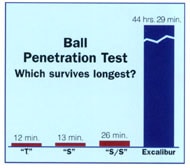The most common complaint about fluoropolymer coatings is that “They wear out too quickly”. That’s why nonstick coatings were rarely seen on expensive cookware and found little success in industrial applications.
To solve this problem, Whitford’s research and development team created Excalibur and patented the formula years ago.
Excalibur is far more than a fluoropolymer coating. It is a unique, externally reinforced system. What makes it different from – and superior to – other coating systems is its remarkable resistance to wear and all types of abrasion.
As the diagrams below illustrate, a patented stainless-steel alloy is sprayed onto a roughened substrate at extremely high temperatures. The molten particles cool and harden, welded to the surface of the substrate. They form a matrix of “peaks” and “valleys” that provide a permanent, rigid base for the coatings.
Three coats of tough fluoropolymer are applied, filling the “valleys” and covering the “peaks”. The coatings are locked into place by the stainless-steel matrix.
Excalibur actually becomes a part of the surface to which it is applied, offering the strength of stainless steel with the low friction and release of the finest nonsticks.
If a spatula or other metal object is scraped over Excalibur, it simply skips over the stainless-steel “peaks” unable to gouge out the nonstick coatings in the “valleys”.
The next advancement
Whitford R&D has been working on internally reinforced coatings for several years now, developing various options to suit a variety of needs.
The option most suited for combination with Excalibur was selected and added to the system. Now this unique coating is reinforced externally as well as internally.
Excalibur is ideal for high-end cookware (especially stainless-steel cookware) and thousands of industrial applications. Now, with the new formula, Excalibur is better than ever.
Two totally different wear tests demonstrate how Excalibur outperforms other coatings. The Ball Penetration Test is a widely accepted method of measuring the durability of fluoropolymer coatings. In this test, a 1/8” Rockwell stainless-steel ball under a 3,000-gram load is placed on a coated aluminum substrate which is rotated in a perfect circle.
The motor driving the substrate is wired to an ammeter to measure the amount of current required to turn the motor. The output is fed to a strip chart, recording the current.
When the ball penetrates the fluoropolymer surface and touches the metal substrate, it drags, drawing more current and causing the strip chart to record a radical change. The time to failure is then noted.
In this series of tests, under precisely the same conditions, coating “T” lasted 12 minutes, coating “S” lasted 13 minutes, coating “S/S” lasted 26 minutes. Yet Excalibur lasted 44 hours and 29 minutes, more than 100 times longer than all three coatings.
In tests conducted by an independent testing laboratory in the United Kingdom, coated steel panels are fixed to a baseplate, which is moved back and forth with a fixed stroke length.
A steel pin with a polished, spherical end is held stationary against the moving coated panel under a load of 10N. After approximately one hour, the wear volume is measured by laser profilometry.
Under identical test conditions, “S/S”, the leading high-priced competitive coating, suffered 130 percent more wear than Excalibur.
Excalibur has as many uses as there are applications requiring the best of release and low friction combined with superior ability to resist all types of abrasive wear.
Typical uses for the unique Excalibur system include:
Abraders • Agitators • Appliance parts • Bakery equipment • Blades • Blowers • Canning machinery • Cereal manufacturing • Chutes • Conveyors • Copy machines • Cutters • Doctor blades • Dry bulk transport • Dust collectors • Earthmoving machinery • Electrostatic filters • Fan blades • Feed troughs • Filling grates • Food processing • Guides • Heat sealing bars and plates • Motorway paving equipment • Ice makers • Industrial cookware • Knitting machines • Knives • Mandrels • Mixer blades • Moldboard ploughs.• Packaging equipment • Paper machinery • Platens • Ploughs • Reactor vessels • Rotary pumps • Slides • Slurry tanks • Snow release • Textile machinery • Valves • Washers • Waste disposal equipment



